Guadalajara, Jalisco 作者: 来源: 发布时间:2021-03-22
1. Basic data
Pop.: 5,002,466 (metro)
Area: 151 km2
Elev.: 1,566 masl
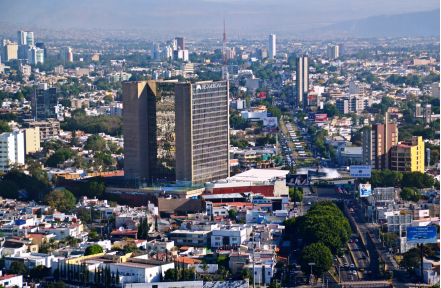
Guadalajara location in Mexico within the state of Jalisco
https://goo.gl/maps/CAdWdNkBqaLjYQ9W8
2. Natural geography
Guadalajara's natural wealth is represented by the La Primavera Forest, Los Colomos, and the Barranca de Huentitán. The flora in these areas includes michoacan pines, several species of oak, sweetgum, ash, willow, and introduced trees such as poincianas, jacarandas and ficus. It also includes orchids, roses and various species of fungi. The fauna includes typical urban fauna in addition to 106 species of mammals, 19 species of reptiles and six species of fish.
La Barranca de Huentitán (the Huentitán Forest) (also known as Barranca de Oblatos and Barranca de Oblatos-Huentitán) is a National Park located just north of the municipality of Guadalajara. The barranca (canyon) borders two colonias (neighborhoods) of the city, Oblatos and Huentitan. It covers approximately 1,136 hectares, and varies 600 meters in altitude. The funicular railway in the park starts at 1000 meters above sea level and rises to 1520 meters above sea level. In the 16th century, during the Spanish Conquest, the Huentitán area including the canyon was the site of battles between local Indian populations and the Spanish. Later, it was the site of battles between different factions during the Mexican Revolution and the Cristero Rebellion.
The canyon is a biogeographic corridor which is home to four types of vegetation: deciduous tropical forest, gallery forest, heath vegetation and secondary vegetation. In addition to introduced species, there are many native species of flora and fauna. The canyon is studied by national and international researchers as it contains great biological diversity due to its geographical location. On June 5, 1997 it was declared a Protected Natural Area, as an Area Subject to Ecological Conservation (Zona Sujeta a Conservación Ecológica).
Weather
Köppen Classification: Humid Subtropical Climate
This climate is characterized by relatively high temperatures and evenly distributed precipitation throughout the year. This climate type is found on the eastern sides of the continents between 20° and 35° N and S latitude. In summer, these regions are largely under the influence of moist, maritime airflow from the western side of the subtropical anticyclonic cells over low-latitude ocean waters. Temperatures are high and can lead to warm, oppressive nights. Summers are usually somewhat wetter than winters, with much of the rainfall coming from convectional thunderstorm activity; tropical cyclones also enhance warm-season rainfall in some regions. The coldest month is usually quite mild, although frosts are not uncommon, and winter precipitation is derived primarily from frontal cyclones along the polar front.
The Köppen Climate Classification subtype for this climate is "Cfa". (Humid Subtropical Climate).
The average temperature for the year in Guadalajara is 68.0°F (20°C). The warmest month, on average, is June with an average temperature of 74.0°F (23.3°C). The coolest month on average is January, with an average temperature of 60.0°F (15.6°C).
The highest recorded temperature in Guadalajara is 103.1°F (39.5°C), which was recorded in April. The lowest recorded temperature in Guadalajara is 28.0°F (-2.2°C), which was recorded in February.
The average amount of precipitation for the year in Guadalajara is 35.8" (909.3 mm). The month with the most precipitation on average is July with 9.8" (248.9 mm) of precipitation. The month with the least precipitation on average is March with an average of 0.1" (2.5 mm). In terms of liquid precipitation, there are an average of 87.9 days of rain, with the most rain occurring in July with 21.2 days of rain, and the least rain occurring in March with 0.7 days of rain.
Getting there and around
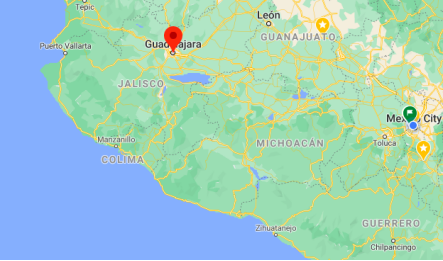
By Air – You can fly to Guadalajara from the US and other points in Mexico including Mexico City, Puerto Vallarta, and Monterrey. The airport is a 10 mile (16.5 km) drive south of Guadalajara, and it will take about 45 minutes for your taxi or ground transportation to get into the city center from there. For detailed information about flights and flying, see the Mexperience guide to Air Travel in Mexico.
By Bus – You can travel to Guadalajara on a luxury bus from Mexico City – the trip takes around 7-8 hours. Luxury buses drop people off at the new bus station in Guadalajara, which is near Tlaquepaque, about a 15 minute taxi ride away from the city center. For detailed information about bus transportation read the Mexperience guide to Bus Travel in Mexico.
By Car – Driving to Guadalajara is very fast and efficient using the many high-speed roads that connect the region. See additional information about Driving in Mexico and Mexico’s Toll Roads on Mexperience.
Car Rental – To explore Mexico independently, consider renting a car for your visit. Having your own car will give you more flexibility than using public transport options and, in some cases, offer you access to places which are otherwise difficult to visit without the use of a car. Read our guide to Car Rental in Mexico to learn what you need to know about car rental in Mexico and connect to the Mexperience Travel Center to reserve your Rental Car.
Taxis – Guadalajara’s taxis are officially metered, but taxis here have been known not to use them. Either insist that the meter be activated (or find another taxi) or agree your price before you get in. Taxi travel is very affordable in Mexico, in comparison to the USA, Canada and Europe, and so provides a viable means of public transportation in Mexico. Your hotel can arrange taxis for you; some post their rates on a board in the lobby; taxi hotel rates are usually higher than cabs you hail off the street. If you speak Spanish, you will have a distinct advantage in your negotiations with local taxi drivers. For detailed information, read the Mexperience guide to Taxi Travel in Mexico.
Buses – Bus trips to local areas (within about 50 miles of Guadalajara) depart from the old bus station, which is in the city center. You can take a local bus to nearby places including Lake Chapala (Chapala, Ajijic, Jacotepec). Long distance buses arrive and depart from the bus station near Tlaquepaque, about 15 minutes from the center of the city.
https://www.mexperience.com/travel/big-cities/guadalajara
Uber/Cabify - You need to know Mexico City and speak Spanish: Don’t take street cabs in Mexico City if you are unfamiliar with the capital and/or don’t speak much Spanish: if you are visiting the city, get your hotel to phone a cab, use a taxi rank cab (see notes above), or use your smartphone to arrange a service like Uber or Cabify.
https://www.mexperience.com/transport/taxi-travel-in-mexico/#51
3. GDP: 80 B USD
4. Industry
Guadalajara has the third-largest economy and industrial infrastructure in Mexico and contributes 37% of the state of Jalisco's total gross production. Its economic base is strong and well diversified, mainly based on commerce and services, although the manufacturing sector plays a defining role. It is ranked in the top ten in Latin America in gross domestic product and the third highest ranking in Mexico.
In its 2007 survey entitled "Cities of the Future", FDi magazine ranked Guadalajara highest among major Mexican cities and designated Guadalajara as having the second strongest economic potential of any major North American city behind Chicago. FDI ranked it as the most business-friendly Latin American city in 2007.
In 2009 Moody's Investors Service assigned ratings of Ba1 (Global scale, local currency) and A1.mx (Mexican national scale). During the prior five years, the municipality's financial performance had been mixed but had begun to stabilize in the later two years. Guadalajara manages one of the largest budgets among Mexican municipalities and its revenue per capita indicator (Ps. $2,265) places it above the average for Moody's-rated municipalities in Mexico.
The city's economy has two main sectors. Commerce and tourism employ most: about 60% of the population. The other is industry, which has been the engine of economic growth and the basis of Guadalajara's economic importance nationally even though it employs only about a third of the population. Industries here produce products such as food and beverages, toys, textiles, auto parts, electronic equipment, pharmaceuticals, footwear, furniture and steel products.
Two of the major industries have been textiles and shoes, which are still dynamic and growing. Sixty percent of manufactured products are sold domestically, while forty percent are exported, mostly to the United States. This makes Guadalajara's economic fortunes dependent on those of the U.S., both as a source of investment and as a market for its goods.
In 2007, fDi magazine stated that Guadalajara has the second strongest economic potential of any major North American city, behind only Chicago. The same research noted Guadalajara as a "city of the future" due to its youthful population, low unemployment and large number of recent foreign investment deals; it was found to be the third most business-friendly city in North America.
The city has to compete with China, especially for electronics industries which rely on high volume and low wages. This has caused the it to move toward high-mix, mid-volume and value-added services, such as automotives. However, its traditional advantage of proximity to the U.S. market is one reason Guadalajara stays competitive. Mexico ranked third in 2009 in Latin America for the export of information technology services, behind Brazil and Argentina. This kind of service is mostly related to online and telephone technical support. The major challenge this sector has is the lack of university graduates who speak English.
5. Touristic sites
Centro Histórico
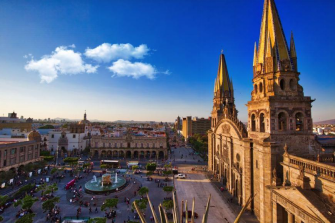
The best way to get introduced to Guadalajara is with a stroll through the Centro Historico (Historical Centre). Here you’ll find tree-lined plazas, gorgeous cathedrals, important cultural institutions, bustling markets, and lots more. It’s a great place for a casual stroll, as there are several pedestrian-only streets.
Start your exploration off in the Plaza de Armas, which is surrounded by the double-spired Guadalajara Cathedral and the historic Governor’s Office. Be sure to walk through the nearby Liberation Square to snap a photo with the Guadalajara sign. Wandering around this square is one of the best free things to do in the city.
From here you have easy access to several museums, such as the Regional Museum of Guadalajara. You could also just grab a coffee and watch the city go about its day.
Live Mariachi Bands
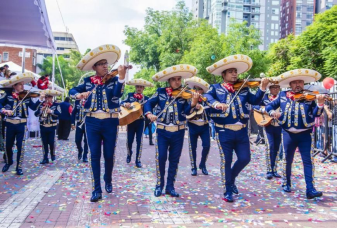
Perhaps no type of Mexican music is more famous than mariachi. It even made the UNESCO list for Intangible Cultural Heritage a few years ago. Everywhere you go in Mexico, the sounds of mariachi music follow, whether it’s a roaming band on the beach or the presidential inauguration ceremony.
It’s believed that modern-day mariachi music originated in Jalisco, the Mexican state that Guadalajara is the capital of. As such, there’s no better place to dive into this traditional Mexican music than right here in GDL.
Head to the Plaza de los Mariachis in the evening and hire a band to serenade you. Just be sure to come prepared with a few songs other than “La Cucaracha.”
Cabañas Cultural Institute
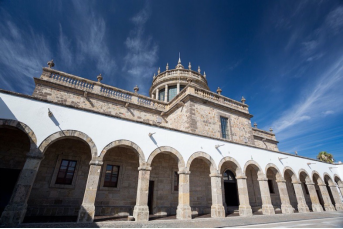
One of the most interesting things to do in Guadalajara is to a visit to the Cultural Institute Cabañas. It was founded in 1791 as a hospital/orphanage by the Bishop of Guadalajara and eventually became a cultural institution. It’s a beautiful neo-classical building with several courtyards and galleries to explore.
The highlight of visiting is definitely seeing the amazing frescoes by Mexican artist Jose Clemente Orozco, including his famous work Hombre de Fuego (The Man of Fire).
It’s closed on Mondays but free to visit on Tuesdays. Otherwise, it costs about $2 to get in and another $1 if you want to use your camera.
Teatro Degollado
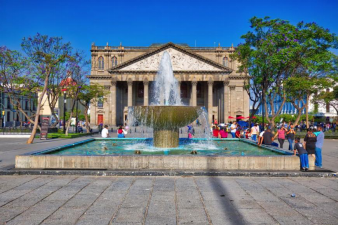
One of the most beautiful buildings in Guadalajara, Teatro Degollado is a neo-classical theatre in the historical centre of the city. To truly admire the building, you’ll have to go inside and see the incredible murals. It’s free to enter when there isn’t a show on.
There are regular performances in the theatre, including operas and symphony orchestras. If you’re lucky, you can score tickets to one of the gala performances during the mariachi festival.
I attended one this year and highly recommend it if you get the chance. Simply stop in when you’re visiting Guadalajara to see if there’s a last-minute show you can attend.
https://www.goatsontheroad.com/things-to-do-in-guadalajara/#1_Explore_the_Historical_Centre
One Day in Guadalajara | Expedia
https://youtu.be/CWXes4XqTN4
6. History and Culture
Pre-Hispanic Era
Unlike the surrounding areas, the central Atemajac Valley, where Guadalajara is located, contained no human settlements. To the east of the Atemajac Valley were the Tonallan and Tetlán peoples. At the extremes were the Zapopan, Atemajac, Zoquipan, Thesistan, Coyula, and Huentitán.
The historic city center encompasses what was once four population centers, as the villages of the Mezquitán, Analco and Mexicaltzingo were annexed to the Atemajac site in 1669.
Foundation
Guadalajara was originally founded at three other sites before moving to its current location. The first settlement in 1532 was in Mesa del Cerro, now known as Nochistlán, Zacatecas. This site was settled by Cristóbal de Oñate as commissioned by Nuño de Guzmán, with the purpose of securing recent conquests and defending them from the still-hostile natives. This settlement did not last long due to its lack of usable water sources. In 1533 it was moved to a site near Tonalá. Four years later, Guzmán ordered that the village be moved to Tlacotán. During this time, the Spanish king Charles I granted the city the coat of arms which it retains to this day.
During the Mixtón War, settlers were attacked by the Caxcan, Portecuex, and Zacateco peoples under the command of Tenamaxtli. The war was initiated in response to the cruel treatment of indigenous peoples by Nuño de Guzmán, in particular the enslavement of captured natives. After multiple defeats, Viceroy Antonio de Mendoza took control of the Spanish campaign to suppress the revolt. The conflict ended after Mendoza made concessions such as freeing Indian slaves and granting amnesty. The village of Guadalajara barely survived the war, and the villagers attributed their survival to the Archangel Michael, who remains the patron of the city to this day.
After the war, the city was moved once again—this time to a more defensible location. This final relocation would prove permanent. In 1542, records indicate that 126 people were living in Guadalajara. That same year, it was granted cityhood by the king of Spain. Guadalajara was officially founded on February 14, 1542 in the Atemajac Valley. The settlement was named for Nuño de Guzmán's Spanish hometown.
In 1559, royal and bishopric offices for the province of Nueva Galicia were moved from Compostela to Guadalajara and, in 1560, Guadalajara became the province's new capital. Construction of the cathedral began in 1563. In 1575, religious orders such as the Augustinians and Dominicans arrived, eventually making the city a center for evangelization efforts.
While capital of the Kingdom of Nueva Galicia, the city's inhabitants achieved a high standard of living, due to flourishing industry, agriculture, commerce, mining and trade.
The Guadalajara of the sixteenth century was a rather small and often overlooked community. It was mainly frequented by traveling merchants. Several epidemics drastically reduced the city's indigenous population, leading to the construction of its first hospital in 1557.
In 1791, the University of Guadalajara was established. The dedication was held in 1792 at the site of the old Santo Tomas College. While the institution was founded during the 18th century, it would not be fully developed until the 20th century, starting in 1925. In 1794, the Hospital Real de San Miguel de Belén, or simply the Hospital de Belén, was opened.
Guadalajara's economy during the 18th century was based on agriculture and the production of non-durable goods such as textiles, shoes and food products.
Despite epidemics, plagues, and earthquakes, Guadalajara would become one of the most important population centers in New Spain. The city's heyday attracted numerous architects, philosophers, lawyers, scientists, poets, writers and speakers; Francisco Xavier Clavijero and Matías de la Mota Padilla were among the most prominent. 1771 saw the arrival of one of the most notable characters in the history of Guadalajara: Bishop Fray Antonio Alcalde, who founded the Civil Hospital and the University of Guadalajara.
In 1793 Mariano Valdés Téllez ran the city's firs printing press, whose first publication was a funeral eulogy for Fray Antonio Alcalde.
Independence
Guadalajara remained the capital of Nueva Galicia with some modifications until the Mexican War of Independence. Miguel Hidalgo entered San Pedro (now Tlaquepaque) on November 25, 1810 and the next day he was greeted effusively in Guadalajara. The city's workers had experienced poor living conditions and were swayed by promises of lower taxes and the abolition of slavery. Despite a soured welcome, due to the rebel army's violence toward city residents, especially royalists, Hidalgo kept his promise and, on December 6, 1810, slavery was abolished in Guadalajara, a proclamation which has been honored since the end of the war. During this time, he founded the newspaper El Despertador Americano, dedicated to the insurgent cause.
Royalist forces marched to Guadalajara, arriving in January 1811 with nearly 6,000 men. Insurgents Ignacio Allende and Mariano Abasolo wanted to concentrate their forces in the city and plan an escape route should they be defeated, but Hidalgo rejected this idea. Their second choice was to make a stand at the Puente de Calderon just outside the city. Hidalgo had between 80,000 and 100,000 men and 95 cannons, but the better-trained royalists won, decimating the insurgent army and forcing Hidalgo to flee toward Aguascalientes. Guadalajara remained in royalist hands until near the end of the war.
On January 17, 1817, the insurgent army was again defeated on the outskirts of Guadalajara in the Battle of Calderón Bridge. New Galicia, now Jalisco, adhered to the Plan de Iguala on June 13, 1821.
In 1823, Guadalajara became capital of the newly founded state of Jalisco. In 1844, General Mariano Paredes y Arrillaga initiated a revolt against the government of President Antonio López de Santa Anna. Santa Anna personally ensured that the revolt was quelled. However, while Santa Anna was in Guadalajara, a revolt called the Three Hour Revolution brought José Joaquín Herrera to the presidency and put Santa Anna into exile.
President Benito Juárez made Guadalajara the seat of his government in 1856, during the Reform War. French troops entered the city during the French Intervention in 1864, and it was retaken by Mexican troops in 1866.
Despite the violence, the 19th century was a period of economic, technological and social growth for the city. After Independence, small-scale industries developed, many of which were owned by European immigrants. Rail lines connecting the city to the Pacific coast and north to the United States intensified trade and allowed the shipment of products from rural areas of Jalisco. Ranch Culture became a very important aspect of Jalisco and Guadalajara's identities during this time. From 1884 to 1890, electrical and railroad services, as well as the Guadalajara Observatory were established.
20th century
Throughout the twentieth century, seeing growth in its industrial, tourist and service industries, Guadalajara began a period of rapid transformation into the metropolis it is today. The city would gain the second largest economy in Mexico, following only by Mexico City. After the Mexican Revolution of 1910, Guadalajara became the second most populous city in the country. However, the decades that followed brought a number of regional wars in the states of Jalisco, Michoacán, and Guanajuato. The aftermath of the Great Depression took further toll on the city. Fortunately, by the 1940s the city would experience industrial, demographic, and trade growth.
In 1910, the Mexican Revolution began, bringing an end to the Porfiriato. With conflict concentrated in the capital, Guadalajara experienced relative calm. After the Cristero Conflict, peace returned to Guadalajara and the city flourished, outgrowing its colonial roots. This period saw the birth of new schools of architecture that would decorate the city from the 1920s to the 1980s.
Guadalajara again experienced substantial growth after the 1930s, and the first industrial park was established in 1947. Its population surpassed one million in 1964 and by the 1970s it was Mexico's second-largest city and the largest in western Mexico. Most of the modern city's urbanization took place between the 1940s and the 1980s, with the population doubling every ten years until it stood at 2.5 million in 1980. The population of the municipality has stagnated, and even declined, slowly but steadily, since the early 1990s.
The increase in population brought with it an increase in the size of what is now called Greater Guadalajara, rather than an increase in the population density of the city. Migrants coming into Guadalajara from the 1940s to the 1980s were mostly from rural areas and lived in the city center until they had enough money to buy property. This property was generally bought in the edges of the city, which were urbanizing into fraccionamientos, or residential areas. In the 1980s, it was described as a "divided city" east to west based on socioeconomic class. Since then, the city has evolved into four sectors, which are still more or less class-centered. The upper classes tend to live in Hidalgo and Juárez in the northwest and southwest, while lower classes tend to live in the city center, Libertad in the northeast and southeast in Reforma. However, lower class development has developed on the city's periphery and upper and middle classes are migrating toward Zapopan, making the situation less neatly divided.
Since 1996, the activity of multinational corporations has had a significant effect on the economic and social development of the city. The presence of companies such as Kodak, Hewlett-Packard, Motorola and IBM has been based on production facilities built outside the city proper, bringing in foreign labor and capital. This was made possible in the 1980s by surplus labor, infrastructure improvements and government incentives. These companies focus on electrical and electronic items, which is now one of Guadalajara's two main products (the other being beer). This has internationalized the economy, steering it away from manufacturing and toward services, dependent on technology and foreign investment. This has not been favorable for the unskilled working class and traditional labor sectors.
The 1992 Guadalajara explosions occurred on April 22, 1992, when gasoline explosions in the sewer system over four hours destroyed 8 km (5 mi) of streets in the downtown district of Analco. Gante Street was the most damaged. Officially, 206 people were killed, nearly 500 injured and 15,000 were left homeless. The estimated monetary damage ranges between $300 million and $1 billion. The affected areas can be recognized by their more modern architecture.
Three days before the explosion, residents started complaining of a strong gasoline-like smell coming from the sewers. City workers were dispatched to check the sewers and found dangerously high levels of gasoline fumes. However, no evacuations were ordered. An investigation into the disaster found that there were two precipitating causes. The first was new water pipes that were built too close to an existing gasoline pipeline. Chemical reactions between the pipes caused erosion. The second was a flaw in the sewer design that did not allow accumulated gases to escape.
Arrests were made to indict those responsible for the blasts. Four officials of Pemex (the state oil company) were indicted and charged on the basis of negligence. Ultimately, however, these people were cleared of all charges. Calls for the restructuring of PEMEX were made but they were successfully resisted.
The 1990s were marked by events such as the explosions of April 22, 1992, the Mexican peso crisis of 1994, and the murder of the Cardinal Juan Jesús Posadas Ocampo in 1993. The 1992 explosions caused massive infrastructure damage to hundreds of houses, avenues, streets, and businesses in the Analco colony, "without a clear delineator of information and responsibilities to date," in one of the most tragic events in the history of Guadalajara. The investigation of the facts lasted more than 11 years in which insufficient evidence was found to appoint a manager investigations are now closed attributing the events to an accident. This event, in addition to Mexico's 1994 economic crisis, resulted in the loss of Guadalajara's industrial power.
Modern era
The city has hosted numerous important international events, such as the first Cumbre Iberoamericana in 1991; the Third Summit of Heads of State and Governments of Latin America, the Caribbean and the European Union in 2004; the Encuentro Internacional de Promotores y Gestores Culturales in 2005; and the 2011 Pan American Games. It was named the American Capital of Culture in 2005 and the Ciudad Educadora (Educator City). in 2006. It was recognized as Mexico's first Smart City due to its use of developing technology. During each government period, the city went through structural plans with which new areas and commercial hubs were born and with which transnational corporations and international industries arrived in the city. The city housed the first shopping malls in Mexico.
The city expanded rapidly before merging with the Zapopan municipality. Among the developments created during this period were the Guadalajara Expo, the light rail, shopping centers, the expansion of streets and avenues, and the birth and development of road infrastructure, services, tourism, industrial, etc. The first shopping center in Latin America emerged in the city, the first urban electric-train system in Latin America, and the first autonomous university in Mexico
A 2007 survey entitled "Cities of the Future", FDi magazine ranked Guadalajara first among major Mexican cities and second among major North American cities in terms of economic potential, behind Chicago. The magazine also rated it as the most business-friendly Latin American city in 2007.
7. Contact Information
City Mayor: Ismael del Toro
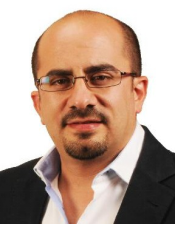
Contact number: +52 (33) 3837 4400
Govt. Office Address: Hidalgo 400, Col Centro, CP: 44100, Guadalajara, Jal.
Twitter: https://twitter.com/deltoroismael?lang=en
FB: https://www.facebook.com/deltoroismael
Website: https://guadalajara.gob.mx
